Related Research Articles

A floating production storage and offloading (FPSO) unit is a floating vessel used by the offshore oil and gas industry for the production and processing of hydrocarbons, and for the storage of oil. An FPSO vessel is designed to receive hydrocarbons produced by itself or from nearby platforms or subsea template, process them, and store oil until it can be offloaded onto a tanker or, less frequently, transported through a pipeline. FPSOs are preferred in frontier offshore regions as they are easy to install, and do not require a local pipeline infrastructure to export oil. FPSOs can be a conversion of an oil tanker or can be a vessel built specially for the application. A vessel used only to store oil is referred to as a floating storage and offloading (FSO) vessel.

Estlink is a set of HVDC submarine power cables between Estonia and Finland. Estlink 1 is the first interconnection between the Baltic and Nordic electricity markets followed by Estlink 2 in 2014. The main purpose of the Estlink connection is to secure power supply in both regions to integrate the Baltic and Nordic energy markets.

Nexans S.A. is a global company in the cable and optical fiber industry headquartered in Paris, France.

Ulstein Group is a group of companies that focus on various marine-related industries, but is mainly known for its shipbuilding and ship design activities. The largest unit is Ulstein Verft AS. The company's head office and primary operations are located in the town of Ulsteinvik in the municipality of Ulstein in Møre og Romsdal county, Norway, an important area for the Norwegian maritime cluster, and with subsidiaries in several other countries. The group also includes companies working with power & control systems and solutions, engineering, site follow-up and aftermarket services. The company has also been engaged in shipping.

Siemens Gamesa Renewable Energy S.A., formerly Gamesa Corporación Tecnológica S.A. and Grupo Auxiliar Metalúrgico S.A., is a Spanish-German wind engineering company based in Zamudio, Biscay, Spain. It manufactures wind turbines and provides onshore and offshore wind services. It is the world's second largest wind turbine manufacturer.

Equinor ASA is a Norwegian state-owned multinational energy company headquartered in Stavanger. It is primarily a petroleum company, operating in 36 countries with additional investments in renewable energy. In the 2020 Forbes Global 2000, Equinor was ranked as the 169th-largest public company in the world. As of 2021, the company has 21,126 employees.
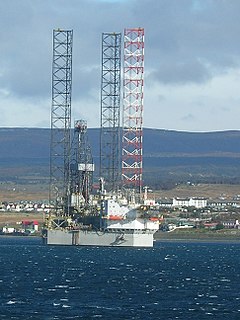
A jackup rig or a self-elevating unit is a type of mobile platform that consists of a buoyant hull fitted with a number of movable legs, capable of raising its hull over the surface of the sea. The buoyant hull enables transportation of the unit and all attached machinery to a desired location. Once on location the hull is raised to the required elevation above the sea surface supported by the sea bed. The legs of such units may be designed to penetrate the sea bed, may be fitted with enlarged sections or footings, or may be attached to a bottom mat. Generally jackup rigs are not self-propelled and rely on tugs or heavy lift ships for transportation.
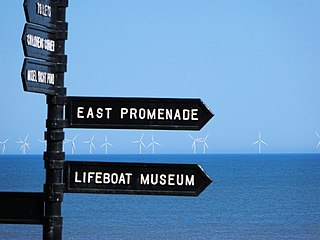
Sheringham Shoal Offshore Wind Farm is a Round 2 wind farm in North Sea off the coast of Norfolk. A lease for use of the sea bed was obtained in 2004 by Scira Offshore Energy, the development gained offshore planning consent in 2008, and was constructed 2009–2011, being officially opened in 2012.

A floating wind turbine is an offshore wind turbine mounted on a floating structure that allows the turbine to generate electricity in water depths where fixed-foundation turbines are not feasible. Floating wind farms have the potential to significantly increase the sea area available for offshore wind farms, especially in countries with limited shallow waters, such as Japan, France and US West coast. Locating wind farms further offshore can also reduce visual pollution, provide better accommodation for fishing and shipping lanes, and reach stronger and more consistent winds.

In ship design, an inverted bow is a ship's or large boat's bow whose farthest forward point is not at the top. The result may somewhat resemble a submarine's bow. Inverted bows maximize the length of waterline and hence the hull speed, and have often better hydrodynamic drag than ordinary bows. On the other hand, they have very little reserve buoyancy and tend to dive under waves instead of piercing or going over them.
GE Wind Energy is a branch of GE Renewable Energy, a subsidiary of General Electric. The company manufactures and sells wind turbines to the international market. In 2018, GE was the fourth largest wind turbine manufacturer in the world.
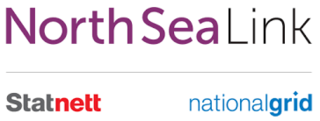
The North Sea Link is a 1,400 MW high-voltage direct current submarine power cable between Norway and the United Kingdom.
The Polish energy sector is the sixth largest in Europe. The scale of energy consumption in 1996–2015 increased from 139,593 GWh to 161,438 GWh. According to the data of Polskie Sieci Elektroenergetyczne (PSE), electricity production in October 2020 amounted to 13,553 GWh; domestic consumption amounted to 14,798 GWh.
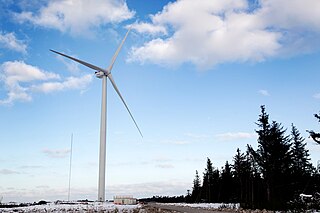
The Vestas V164 is a three-bladed offshore wind turbine, produced by Vestas, with a nameplate capacity of up to 10 megawatts, a world record. Vestas revealed the V164's design in 2011 with the first prototype unit operated at Østerild in northern Denmark in January 2014. The first industrial units were installed in 2016 at Burbo Bank, off the west coast of the United Kingdom. By 2021, Vestas had produced 500 of the series.

A wind turbine installation vessel (WTIV) is a vessel specifically designed for the installation of offshore wind turbines. There were 16 vessels in 2020.
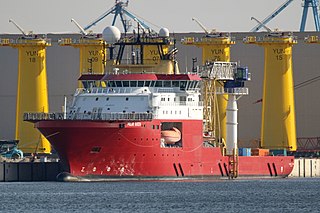
RV Falkor (too) is an oceanographic research vessel being refit in 2021–2022 from the former multi-role offshore support vessel MS Polar Queen. The ship was purchased by the Schmidt Ocean Institute in March 2021. It replaced the RV Falkor.

KRI Usman Harun is a Bung Tomo-class corvette in service with the Indonesian Navy as of 2014. She was originally built for the Royal Brunei Navy and launched as KDB Bendahara Sakam in 2001. Usman Harun is the third ship of the Bung Tomo class.

KRI Bung Tomo is a Bung Tomo-class corvette in service with the Indonesian Navy as of 2014. She was originally built for the Royal Brunei Navy and launched as KDB Jerambak in 2002. Bung Tomo is the lead ship of her class.
The Musheribclass is a class of offshore patrol vessels built by Fincantieri for the Qatari Emiri Navy.
References
- ↑ Durakovic, Adnan (2020-06-11). "Nexans Aurora Leaves Poland". Offshore Wind. Archived from the original on 2022-02-11. Retrieved 2022-02-11.
- ↑ Skopljak, Nadja (2020-06-15). "Nexans Aurora Arrives in Norway". Offshore Wind. Archived from the original on 2022-02-11. Retrieved 2022-02-11.
- 1 2 Buljan, Adrijana (2020-11-09). "Nexans Launches CLV Aurora". Offshore Wind. Archived from the original on 2022-02-11. Retrieved 2022-02-11.
- ↑ Ajdin, Adis (2020-11-09). "Nexans Aurora launched in Norway". Offshore Energy. Archived from the original on 2022-02-11. Retrieved 2022-02-11.